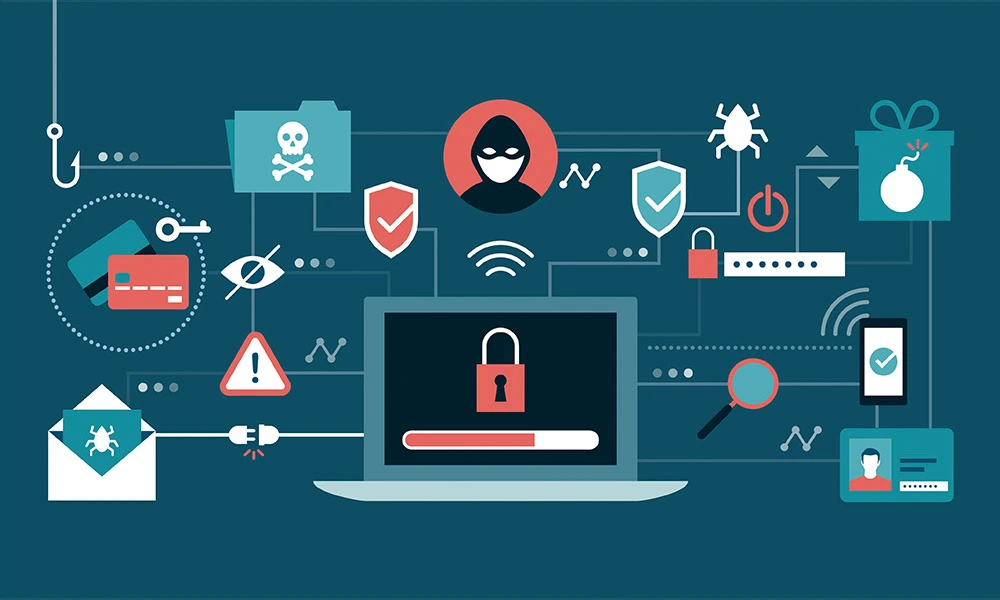Websites have become an integral part of businesses, serving as a gateway to reach and engage with customers. However, with the increasing reliance on the internet, the risk of cyber threats and attacks has also escalated. This is why web security plays an important part in keeping your vulnerable website safe from silent threats. It is common that website owners often neglect the fact that their website can be hacked or they just think that their website won’t be targeted by a hacker. It is crucial for website owners to be proactive in safeguarding their online presence from silent threats that can compromise their data, reputation, and user experience.
In this blog, we will explore six easy and effective web security to protect your website: installing SSL, preventing SQL injection, and securing file uploads.
What is Web Security and Why it is Important

Before going into the 6 practices, let’s understand what Web Security is and why it is important.
Web security refers to the practices and measures implemented to protect websites and web applications from potential threats, vulnerabilities, and unauthorized access. It involves various techniques and strategies aimed at ensuring the confidentiality, integrity, and availability of data and resources associated with a website. Web security is of utmost importance due to the following reasons:
- Protection against Cyber Attacks: Websites are prone to various cyber attacks, such as hacking, malware infections, phishing attempts, and distributed denial-of-service (DDoS) attacks. Web security measures help safeguard against these threats, preventing unauthorized access, data breaches, and potential damage to the website’s reputation.
- Safeguarding User Data: Websites often collect and store sensitive user information, including personal details, financial data, and login credentials. Ensuring web security is crucial for protecting this data from unauthorized access or misuse, maintaining user privacy, and complying with data protection regulations.
- Maintaining Business Reputation: A compromised website can lead to negative consequences, including loss of customer trust, damage to brand reputation, and potential legal implications. By prioritizing web security, businesses can demonstrate their commitment to protecting user information, building trust, and preserving their reputation.
- Compliance with Regulations: Many industries have specific security and privacy regulations that websites must adhere to, such as GDPR, HIPAA, or PCI DSS. Implementing robust web security measures helps businesses meet these compliance requirements and avoid penalties or legal consequences.
- Business Continuity: A secure website ensures uninterrupted availability and functionality, minimizing downtime due to security incidents or attacks. By preventing disruptions, businesses can maintain continuous online operations, provide a seamless user experience, and avoid potential financial losses.
- Protection against Data Loss: Regular backups, secure data storage, and disaster recovery plans are integral components of web security. These measures help protect against data loss due to hardware failures, natural disasters, or malicious activities, ensuring that critical website data can be restored if needed.
Why Would Someone Attack My Website?

It’s important to understand the motivations behind website attacks to better protect yourself. Hackers may have various reasons to go after your website, such as seeking financial gain, stealing valuable data, causing disruption, or even settling personal scores. When unauthorized individuals gain access to your website, they can exploit vulnerabilities, steal sensitive information, inject malicious code, or use your platform to distribute harmful malware.
Websites with valuable data or high traffic are especially attractive to attackers looking to profit. By recognizing these motives, you can assess the risks and take proactive measures to keep your online presence safe and secure.
Now, Let’s take a look at some of the practices website owners could do to improve their website security.
Method 1: Installing SSL (Secure Socket Layer)

One of the fundamental steps in a cyber security website is implementing SSL encryption. SSL ensures secure communication between a user’s browser and your website, encrypting sensitive data such as login credentials, credit card information, and personal details. By installing an SSL certificate, you establish a secure connection, indicated by the padlock icon in the browser’s address bar. This not only protects user data but also enhances trust and credibility, improving your website’s reputation.
Method 2: Preventing SQL Injection Attacks
SQL injection attacks pose a significant threat to websites that rely on databases for storing and retrieving information. Hackers exploit vulnerabilities in web forms or poorly designed queries to inject malicious SQL code, potentially gaining unauthorized access to your database. To prevent SQL injection, it is essential to follow secure coding practices such as using parameterized queries or prepared statements, input validation, and sanitizing user input. Regularly updating and patching your website’s software and plugins also helps to mitigate vulnerabilities.
Method 3: Secure File Uploads
Allowing users to upload files to your website can introduce security risks if not properly managed. Malicious files can be disguised as harmless documents and, when uploaded, can compromise your website’s integrity. To secure file uploads, implement strict file type validation and size restrictions, utilize server-side validation, and conduct robust security checks on uploaded files.
Additionally, storing uploaded files outside of the web root directory and renaming them with randomized names can provide an extra layer of security. By storing uploaded files outside the web root directory, you prevent direct access to sensitive system files and reduce the risk of unauthorized access from the outer party. Renaming the files with randomized names adds an additional level of obscurity, making it harder for attackers to guess or discover the file paths. This practice helps protect against potential attacks that target uploaded files, such as malicious code injection or unauthorized access attempts.
By implementing these measures, you can enhance the overall security of your website and safeguard the integrity of user-uploaded content.
Method 4: Implementing Web Application Firewalls
Web Application Firewalls (WAFs) act as a protective shield between your website and potential threats. WAFs analyze incoming web traffic, filter out malicious requests, and block unauthorized access attempts. They can detect and mitigate various attacks, including cross-site scripting (XSS), cross-site request forgery (CSRF), and distributed denial-of-service (DDoS) attacks. Implementing a reliable WAF helps fortify your website’s defenses and provides an additional layer of protection.
Method 5: Conducting Regular Security Audits
Regular security audits are essential to identify and address potential vulnerabilities in your website’s infrastructure and code. Conduct comprehensive vulnerability assessments and penetration testing to uncover any weaknesses that could be exploited by attackers. Address identified vulnerabilities promptly and establish a proactive approach to ensure ongoing security. Regular audits help you stay one step ahead of potential threats and maintain a robust security posture.
It is crucial that website owners conduct regular checks. They help identify vulnerabilities, prevent data breaches, ensure compliance with regulations, mitigate emerging threats, and enhance user trust. By conducting regular audits, you can proactively identify and address potential security weaknesses, safeguard sensitive data, and demonstrate your commitment to protecting user information. This builds trust with your audience and minimizes the risk of security breaches, ultimately ensuring the long-term success of your online presence.
Method 6: Keeping Software Up to Date
Outdated software, including content management systems (CMS), plugins, themes, and server components, can become an easy target for attackers as it may contain . Regularly updating all software components to the latest stable versions is crucial to patch security vulnerabilities and benefit from the latest security enhancements. Enable automatic updates whenever possible and stay informed about security patches and advisories from software vendors.
Conclusion
Protecting your website from silent threats is a critical aspect of maintaining a secure online presence. By implementing the six essential methods discussed in this blog – installing SSL, preventing SQL injection attacks, securing file uploads, implementing web application firewalls, conducting regular security audits, and keeping software up to date – you can significantly reduce the risk of data breaches, unauthorized access, and compromised user experiences. Remember, website security is an ongoing process that requires continuous monitoring, proactive measures, and adherence to best practices. Stay vigilant, prioritize security, and safeguard your website against silent threats to ensure the trust and confidence of your visitors.
By taking proactive measures and investing in comprehensive site security, you demonstrate your commitment to protecting sensitive information, preserving your reputation, and providing a safe browsing experience for your users.
Yes Web Design Studio
Tel. : 096-879-5445
LINE : @yeswebdesign
E-mail : info@yeswebdesignstudio.com
Facebook : Yes Web Design Studio I Web Design Company Bangkok
Instagram : yeswebdesign_bkk
Address : 17th Floor, Wittayakit Building, Phayathai Rd, Wang Mai, Pathum Wan, Bangkok 10330 (BTS SIAM STATION)









